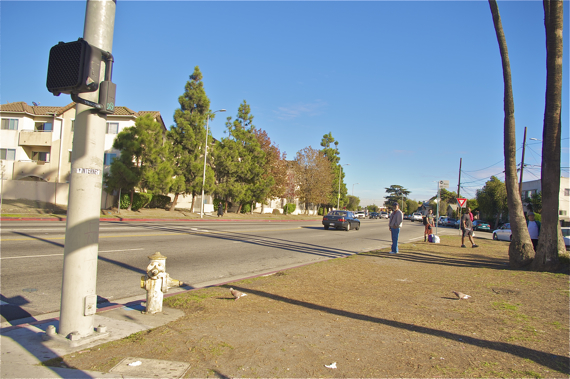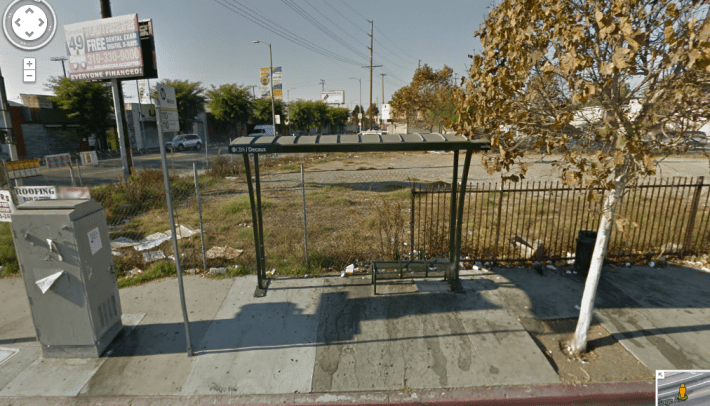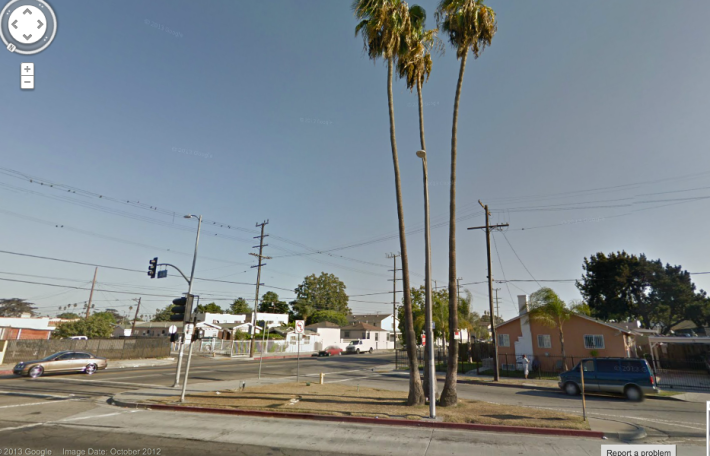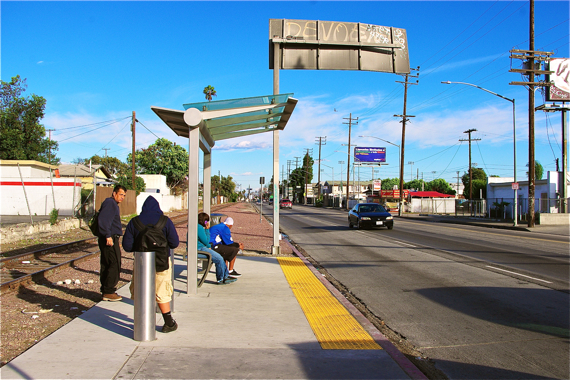People Get Ready: Winter Is Upon Us And Bus Stops Will Not Shelter You
8:51 AM PST on December 6, 2013

I'll admit I don't take the bus very much.
I have debilitating motion sickness. I can't even snap my head from side to side quickly without getting nauseous. The constant stopping, starting, and general rocking back and forth of a bus can make a basket case out of me, even when I am drugged up on dramamine.
But, I do pass a lot of bus stops on my bicycle jaunts around the city and I often think that if anyone wanted to know how the city really felt about its lower-income residents, the bus stops in areas like South L.A. are awfully telling.
As I noted here, they certainly don't provide much in the way of shelter from the sun in the heat of the summer.
And, they generally have some combination of foibles, meaning they often aren't comfortable, clean, safe, or easily accessible places.
As winter comes and the days are both shorter and sometimes wet, these problems come into sharper relief.
If you're female, for example, and you spend too much time waiting at (or even walking to) stops along S. Figueroa (in the 10 - 15 blocks north of Century) or certain stretches of Western (just north of Slauson or around 39th), you might be mistaken for a prostitute and followed, harassed, and/or propositioned.
Or, as once happened to me on Western (near the Bronco Motel), you could be stalked by a pimp.
While not a pleasant experience in broad daylight, these sorts of things can make trying to get where you need to go after dark a much unhappier and more perilous endeavor. Poor lighting around some stops do not help the situation.

Stops can also be dangerous if you are a young male of color -- you're a sitting duck for anyone who feels like messing with you, should you happen to live in or need to move through gang turf. A number of youth I've worked with have reported being harassed or jumped by gang members at stops while waiting for a bus to go to school.
As you can imagine, things don't get better for them after dark, either. Some say their parents don't want them waiting for the bus or walking back and forth to a stop at night -- even to go to programs at rec centers -- meaning that their mobility is seriously curtailed in the winter.
Liquor stores near bus stops can also create a more hazardous environment. A mother of a teen living in the Gonzaque/Haciendas housing development told me she would rather drive her son to his destination than allow him to wait for the bus at 105th and Compton after a walk-up shooting in front of the liquor there this summer. This, despite the fact that the stop is just two blocks from their home and adjacent to a middle school.
Where Metro has managed to alleviate some of the issues like these from rail stops with the placement of cameras, safety ambassadors, better lighting, or law enforcement officers, the bus stops are largely on their own, interwoven with and at the mercy of the fabric of the surrounding sidewalk. Devoid of public art, civic pride, security, or even, it often appears, regular maintenance or trash pick-ups, stops can turn into magnets for unhealthy and unsanitary activities.

That's if riders even get an actual formal stop.
Along Gage (see photos at top of story and below), riders must wait on dirt islands.

Odder still, while the adjacent sidewalk is ADA compliant, if you want to get yourself, your stroller, or whatever wheeled thing you are trying to move up onto the island -- even just to safely cross the street -- you are quite out of luck.

And, while I'm not necessarily in favor of paving over every last square inch of L.A., it would seem that the least the city could do was ensure that riders didn't have to stand ankle-deep in mud during the rainy season. Right?
Expecting the level of investment seen at rail stations at each of the nearly 9,000 bus stops around the city is not realistic, of course. But something has to change to make the system feel more safe, attractive, and like it is something the city hasn't forgotten about.
As discussed here and here, perceptions about the safety, value, and efficacy of the system may be just as important as actual safety, value, and efficacy metrics in wooing discretionary riders or preventing current riders from choosing private vehicles when they have the chance. Meaning, that all the effectiveness in the world may not be enough when you have unlit dirt-mound bus stops like those along Gage telling riders, "We don't actually care if you get to your destination."
The current strategy for managing stops - turning over placement and maintenance of street furniture at stops to outdoor advertiser CBS/Decaux - has clearly not done enough to mitigate the problem.
As I noted here, the excessively bureaucratic permitting process gave CBS/Decaux an excuse to stop requesting permits for furniture installations, meaning that, 12 years into the contract, a large percentage of shelter furniture still hasn't been installed, most notably in lower-income areas. (For the full audit of the program, click here). And, that furniture which has been placed is not particularly well-taken care of.
Although the 20-year contract with CBS/Decaux doesn't end until 2021, it shouldn't mean that we can't do better by the bus system in the meanwhile.
Planners currently working on updating the Mobility Element are doing their part to create a Transit-Enhanced Network to increase service and create all-day or peak-period bus-only lanes along prioritized routes.
But getting people to believe that "buses do it better" will likely require tangible investments in the infrastructure around the system -- bright and clean shelters devoid of advertising, public art, plants, sheltering trees, waste receptacles, lighting, and/or regular maintenance of the stops. Any one of those things would be a baby step in the right direction. Hell, when I saw these shelters (below) begin popping up along Slauson several months ago, I actually wanted to sit at a shelter and ride the bus.

Of course, that thought occurred to me on a brilliant sunny day. Not during a downpour.
There is no doubt that the bus system has its share of problems, the environment and condition of the stops being only two of many.
But investing in fixing some of those aspects will be helpful in making bus-riding feel less like a punishment for those that have no alternative options and more attractive to those that do.
Which is your least favorite bus stop and why? Let us know below...
Sahra is Communities Editor for Streetsblog L.A., covering the intersection of mobility with race, class, history, representation, policing, housing, health, culture, community, and access to the public space in Boyle Heights and South Central Los Angeles.
Stay in touch
Sign up for our free newsletter
More from Streetsblog Los Angeles
Metro Board Funds Free Student Transit Pass Program through July 2025
Metro student free passes funded another year - plus other updates from today's Metro board meeting
Eyes on the Street: New Lincoln Park Avenue Bike Lanes
The recently installed 1.25-mile long bikeway spans Lincoln Park Avenue, Flora Avenue, and Sierra Street - it's arguably the first new bike facility of the Measure HLA era




